All construction projects are expected to adhere to defined construction standards enforced by the legislation and regulatory bodies governing the project. These standards are set to ensure the integrity, efficiency, sustainability, and safety of the construction workplace and building. In preparation for construction, it is important to acquire the necessary approvals and permits from the local government and avail regulatory requirements from specified bodies to get the construction project rolling.
Conditions of Approval for Building and Construction Projects
Before a building and construction project can begin, planned construction activities must be approved by local government entities and relevant regulatory bodies. Building and construction projects must meet conditions set by the local government to obtain approval for construction activities. These conditions ensure that building and construction regulations and standards are adhered to.
Different states/territories have different building administrations. The relevant building administration for each state/territory is as follows:
|
State/Territory |
Local Building Administration |
|
Australian Capital Territory |
ACT Department of Environment, Planning and Sustainable Development |
|
New South Wales |
|
|
Northern Territory |
|
|
Queensland |
|
|
South Australia |
|
|
Tasmania |
|
|
Victoria |
|
|
Western Australia |
Since different building administrations handle building and construction matters in each state/territory, conditions of approval also vary between states/territories. To find out what these conditions are for your state/territory, you must review the building application process in your jurisdiction. While the processes may be different in each state/territory, the fundamental steps are the same.
These steps are: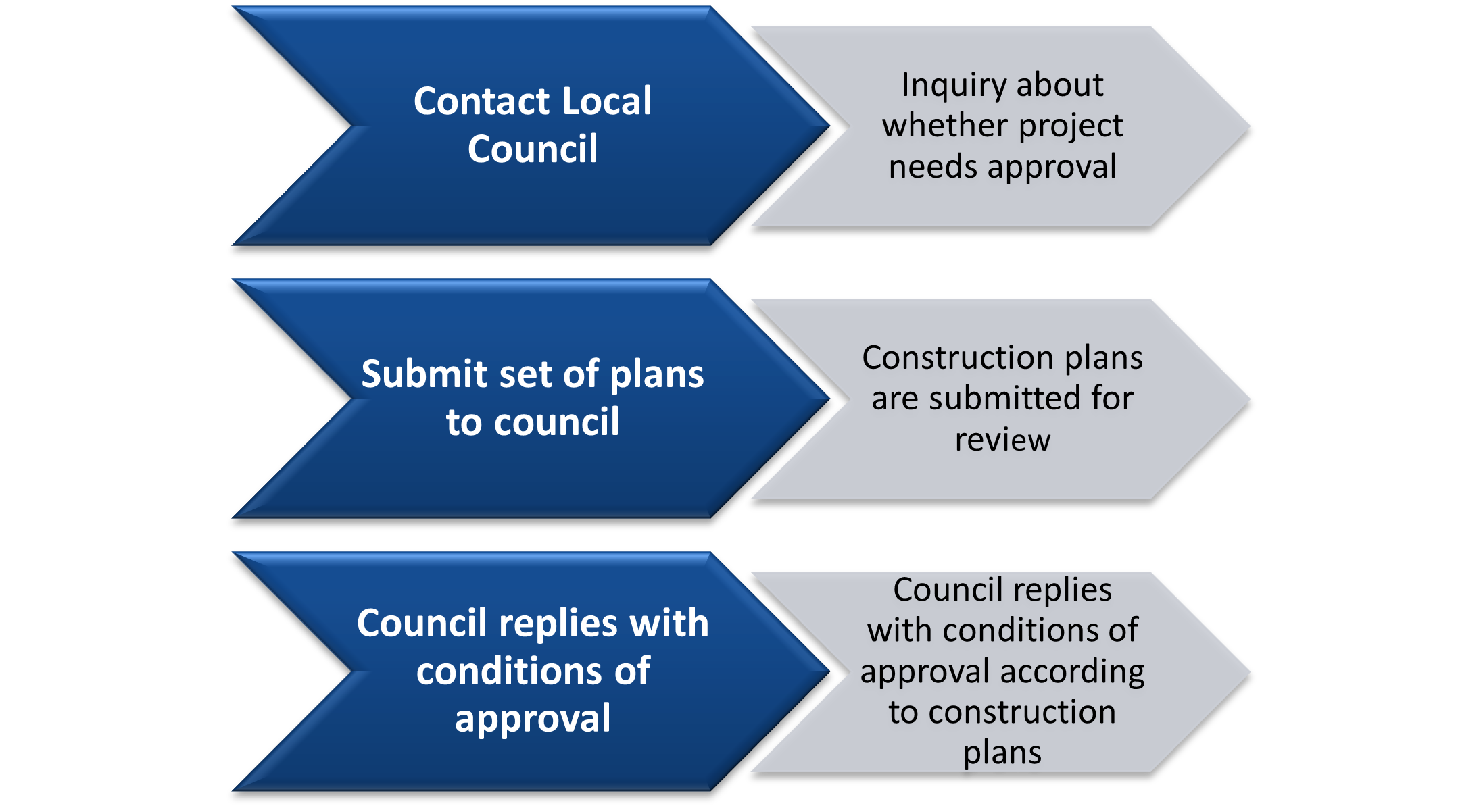
You can access your state/territory's specific building application process in the table below:
|
State/Territory |
Building Application Process Information |
|
Australian Capital Territory |
|
|
New South Wales |
|
|
Northern Territory |
|
|
Queensland |
|
|
South Australia |
|
|
Tasmania |
|
|
Victoria |
|
|
Western Australia |
For example, the building application process for the Australian Capital Territory (ACT) is as follows:
- Check what types of approval the project needs (e.g. development approval, building approval, etc.)
- If development approval is required:
- Prepare the approval application and include the developments
- Lodge the completed application using the eDevelopment website
- Pay the fees
- If a building approval is required:
- Appoint a licensed building surveyor as the certifier
- Complete the Application for Building Approval form
- Lodge the completed forms and include the building plans and specifications
- Pay the required fees
- If the building and construction work needs a licensed builder:
- Engage a licensed builder or
- Apply to become a licensed owner-builder
- Apply for other approvals required for the project
Based on Do I need approval?, used under CC BY 4.0.© Australian Capital Territory
In building approval application, the council will check your construction plans against the regulations, codes, and standards enforced in the state/territory. For example, in the ACT, the Building Act 2004 outlines the minimum safety, health, amenity, and sustainability standards of new buildings in the territory. More information on building regulations, codes, and standards will be discussed in the next sections.
Building and Construction Codes and Standards
All construction activities must comply with the building and construction codes and standards enforced in that state/territory. These codes and standards set out the minimum technical requirements that a building must meet to be considered adequate. While these codes and standards may differ slightly between states/territories, all building and construction codes and standards enforced in Australia use the National Construction Code (NCC) of Australia as the baseline for compliance.
National Construction Code (NCC)
To ensure that buildings perform to a minimum standard, the Australian Building Codes Board (ABCB) publishes and maintains the National Construction Code (NCC). The NCC is a uniform set of technical design, construction, and performance requirements of all new and existing buildings and plumbing and drainage systems throughout Australia. The NCC guidelines serve as pre-requisites for health and safety, amenity, accessibility, and sustainability that a building must meet. Project personnel in charge of overseeing the building and construction project can use the NCC as a guide when monitoring the project's progress to ensure that government requirements are met and use it as a metric for evaluating the project's progress. The NCC can also affect multiple aspects of the project, such as the materials that must be purchased, the construction methods to be used, and the building's design.
The NCC is comprised of the Building Code of Australia (Volumes One and Two) and the Plumbing Code of Australia (Volume Three). The Building Code of Australia defines the classification of buildings in the country. Specifically, each volume applies to the following:
|
NCC Volume One |
NCC Volume Two |
NCC Volume Three |
|
Multi-residential, commercial, industrial, and public buildings and structures (Class 2 to 9) |
Residential (single-dwelling) and non-habitable buildings and structures (Class 1 & 10) |
Plumbing and drainage for all building classes
|
As mentioned earlier, the NCC applies to all building and construction works in Australia. While states/territories may enforce their own building and construction codes, they are all enforced with the NCC as a baseline for building approval requirements.
State/Territory Construction Codes of Practice
The labourers in building and construction are also protected by state/territory government entities' codes of practice. These codes of practice provide management with an idea of what policies and procedures must be put into place on a project site by providing practical guidance regarding the application of Work Health and Safety (WHS) requirements (which will be discussed in Section 1.1.3). These codes of practice can be applied by (but not limited to) implementing processes (i.e. identifying hazards and their associated risks) for risk management into general building and construction work as per the guidelines found in it. Persons conducting business and undertaking (PCBUs) may also follow recommendations and examples of how WHS consultation and participation can be integrated into different processes of risk management. It is important to remember that these codes of practices do not replace WHS laws but rather issued to comprehend its standards better.
At the time of this writing, only the Australian Capital Territory, New South Wales, the Northern Territory, and Tasmania have specific codes of practice for construction work. However, other states/territories may have codes of practice relevant to construction work, such as Queensland's concrete pumping code of practice and Western Australia's prevention of falls from height at workplaces code of practice. You can access the relevant codes of practice for each state with the links below.
|
State/Territory |
Construction code of practice |
|
Australian Capital Territory |
|
|
New South Wales |
|
|
Northern Territory |
|
|
Queensland |
|
|
South Australia |
|
|
Tasmania |
|
|
Victoria |
|
|
Western Australia |
Building and Construction Industry Standards

Standards are specifications and procedures that have been set out by particular organisations so that processes, systems, and services are consistent and reliable. Standards are often used in legislation to provide a baseline of what is considered safe. In building and construction, standards are referenced by the NCC and some codes of practice to ensure the consistency or safety of the building being constructed and the construction workers. It is important to remember that while legislation may enforce standards, the standards themselves are not legally binding. Standards only begin to hold legal weight when they are enforced by legislation.
Industry standards are categorised according to their scope. These categories are:
| International standards | Regional standards | National standards |
 |
 |
 |
The standards and conformance infrastructure of Australia is maintained by four bodies, which include:

Examples of standards that apply to building and construction are standards relevant to a building's sound insulation. This includes:
- AS/NZS ISO 717.1-2004 Acoustics - Rating of sound insulation in buildings and of building elements - Airborne sound insulation
- AS ISO 717.2-2004 Acoustics - Rating of sound insulation in buildings and of building elements - Impact sound insulation
- AS/NZS 2499-2000 Acoustics - Measurements of sound insulation in buildings an of buildings elements - Laboratory measurement of room-to-room airborne sound insulation of a suspended ceiling with a plenum above it
- AS/NZS ISO 140.7-2006 Acoustics - Measurement of sound insulation in buildings and of building elements - Field measurements of impact sound insulation of floors (ISO 140-7:1998, MOD)
- ISO 10052:2004 Acoustics - Field measurements of airborne and impact sound insulation and of service equipment sound - Survey method
- ISO 15186-2:2003 Acoustics - Measurement of sound insulation in buildings and of building elements using sound intensity
Complying with standards is one way to achieve compliance with government minimum requirements set out in the NCC. Also, standards serve as concrete examples of best practice that can then be used to model what needs to be done in a building and construction project. They serve as thresholds that the project must meet to achieve safety, sustainability, and proper functionality. These standards are also used to assess the completed building, so referring to them during the construction phase means greater chances of passing these assessments.
Building and Construction Regulations and Legislation
Legislation and regulation are what enforce the codes and standards discussed in the previous section. As codes and standards, legislation and regulation are specific to states/territories; however, Commonwealth legislation applies to all states/territories in Australia. Additionally, some state/territory laws cover areas not covered by Commonwealth law, or the laws they enforce are in line with Commonwealth law. In cases where laws are inconsistent between Commonwealth and state/territory, the Commonwealth law prevails.
Commonwealth Legislation in Building and Construction
Legislation enacted relevant to the building and construction industry aims to support its professionals and workers, providing a framework for ideal worksites and work settings and environmental sustainability. The following are Commonwealth legislation that applies to the building and construction industry:
|
Commonwealth legislation |
Description |
|
Promotes fairness in trade and competition, the Australian Competition and Consumer Commission (ACCC) enforced the CCA, which covers most areas of the trade market. This includes relations among suppliers, wholesalers, retailers, and consumers levelled equally within the trading industry. |
|
|
The Environment Protection and Biodiversity Conservation Act 1999 (EPBC Act) |
The EPBC Act enables the Australian Government to join with the states and territories in providing a truly national scheme of environment and heritage protection and biodiversity conservation. |
|
Building and Construction Industry (Improving Productivity) Act 2016 |
Provides a framework for improved workplace relations in building work. Ensures that building work is carried out fairly, efficiently, and productively. |
|
Protects the freedom of independent contractors, recognise independent contracting, and prevent interference with the terms of genuine independent contracting arrangements. |
|
|
Provides for a balanced and nationally consistent framework to secure the health and safety of workers and workplaces. |
|
|
Provides a balanced framework for cooperative and productive workplace relations that promotes national economic prosperity and social inclusion for all Australians. |
Fair Work Act 2009
Industrial laws are governing laws explicitly designed as guiding parameter and regulator of industries. The foundation for these provisions is embodied by the Fair Work Act 2009. This legislation tackles the promotion of equal economic opportunity for Australians and serves as the basis for employment standards and welfare.
Detailed information is provided in the Fair Work Act 2009.
Found in the table below are legislation not excluded by the Fair Work Act 2009 of each State/Territory:
|
State/Territory |
Industrial laws not excluded by the Fair Work Act 2009 |
|
Australian Capital Territory |
|
|
New South Wales |
|
|
Northern Territory |
|
|
Queensland |
|
|
South Australia |
|
|
Tasmania |
|
|
Victoria |
|
|
Western Australia |
Work Health and Safety Act (WHS Act) in Building and Construction
One of the priorities of a developer or contractor is that everyone's health and safety in the workplace are taken into consideration. The building and construction work environment can be hazardous and is paired with occupational risks. Therefore, it is the responsibility of everyone in the organisation to abide by WHS practices as being a legal requirement and crucial for the entirety and completion of the project.
The WHS Act defines strict health and safety requirements for the protection of all workers at work and other people who might be affected by the work. It is the legal obligation or duty of everyone to adhere to these requirements.
The table below provides links to complete information for WHS regulations in each State/Territory.
|
State/Territory |
WHS regulations |
|
Australian Capital Territory |
|
|
New South Wales |
|
|
Northern Territory |
Work Health and Safety (National Uniform Legislation) Act 2011 |
|
Queensland |
|
|
South Australia |
|
|
Tasmania |
|
|
Victoria |
|
|
Western Australia |
Safe Work Method Statement (SWMS)
When a construction project involves high-risk construction work, a Safe Work Method Statement (SWMS) is required under WHS regulation. An SWMS is a document that identifies the high-risk construction work at the workplace, the possible hazards that relate to these activities, and most importantly, the measures to be placed in anticipation of the risks. An SWMS functions as a tool to help the supervisor and workers monitor and control measures required at the workplace. SWMS procedure is further detailed in the WHS regulation of each state/territory.
The specific contents required in an SWMS depends on the WHS regulation enforced in your jurisdiction. For example, the ACT Work Health and Safety Regulations 2011 specifies the following information as needed in an SWMS:
- The work that is considered high-risk construction work.
- The hazards related to the high-risk construction work.
- The health and safety risks associated with those hazards.
- A description of the risk control measures to be implemented.
- A description of how the risk control measures that are going to be:
- Implemented
- Monitored
- Reviewed
State/Territory Environmental Management Regulations
Regulatory bodies also manage the effect of a construction project on the environment in each state/territory. The local government may not approve a construction project whose commencement is expected to be detrimental to the environment. To avoid this, you must check with your jurisdiction's regulatory body in charge of environmental management if the construction project you are working on needs such approval to commence.
The following are the regulatory bodies overseeing environmental management in each state/territory.
|
State/Territory |
Environmental Management Regulatory Body |
|
Australian Capital Territory |
|
|
New South Wales |
|
|
Northern Territory |
|
|
Queensland |
|
|
South Australia |
|
|
Tasmania |
|
|
Victoria |
|
|
Western Australia |
Each state/territory enforces their own environmental legislation. A list of state/territory-specific environmental acts implemented in each state/territory is available below.
|
State/Territory |
Legislation enforced by Environmental Management Body |
|
Australian Capital Territory |
|
|
New South Wales |
|
|
Northern Territory |
|
|
Queensland |
|
|
South Australia |
|
|
Tasmania |
|
|
Victoria |
|
|
Western Australia |
|
In cases where a construction project may impact the environment, the regulatory body may require an Environmental Management Plan (EMP) to be accomplished by the person in charge of the construction. An EMP is a document where the environmental impact of a particular building and construction project is detailed, along with information on how the organisation in charge of the project plans to avoid these impacts or at least minimise and manage them. There are two types of EMPs: the construction EMPs (CEMPs) and operation EMPs (OEMPs).
CEMPs are used during the project's actual construction to ensure the protection and preservation of the environment. OEMPs are used after project construction is done, during the actual operation or use of the project, and once the project is being decommissioned.
Project Start Preparation

Project start preparation, as the name implies, is the process of preparing for the construction project to commence. This typically means preparing a document that contains information about conditions the project must meet before it is allowed to begin. In the project start preparation document, you will be filling out information about the project as you identify the information being asked. One of the first things you need to identify in a project for a project start preparation document is its commencement date.
The commencement date of a project is when operations or construction work begins at the construction site. Operations or construction work may involve physical construction work or the installation of equipment or materials. The commencement date of a project is usually specified in the contract.
Below are the contents of a generic project start preparation template.
Project Information
| Target start date | |
| Target end date | |
| Location |
Approval Conditions
The conditions that the project must meet before work can begin.
| Local government body relevant to the building and construction project | |
| Approval conditions |
After completing this section, you should have the information you need to fill out this section of the project start preparation template.
The relationship between client and contractor is defined by the contract under which both parties have an agreement. This contract represents the expectations and demands of the client, which the contractor needs to meet. However, between the signing of the contract and the construction project's completion, variations from the contract may occur. Variations in construction projects are the specific changes or adjustments made that affect their original design. Alterations involve the scope of works indicated in the construction contract are aimed to either enhance it or replace a part of it with an alternative.
In a construction project, regardless of its size, it is expected to undergo necessary variations from its original design. The advancement in technology, implementation of new or revisions of current statutory laws, worksite conditions, geological differences, limitations of specified materials, or continuous improvement in design all create needed changes to better the project. Variations in design, specifications, and drawings can be very significant or relatively minor, depending on whether the construction project is sizably large or small.
Building and Construction Contracts
A construction contract is an arrangement that regulates the relationship between the client and a contractor. Terms and agreements will be defined in the construction contract. There will be main provisions in the building contract relating to:
| Time | Costs | Standard of work that the contractor must do |
 |
 |
 |
Several attachments will also be included in the building contract, including the scope of the work and any plans and requirements for the construction. It is important to distinguish that contracts differ from workplace agreements because the later must be approved by and registered with the Fair Work Commission (FWC) or other government body. Contracts need no such approval.
Independent Contractors Act 2006
This legislation recognises independent contracting as a legitimate form of work and provides legality of service contracts engaged by independent contractors. Genuine independent contracting agreement terms are safeguarded through the legislation.
Exact information regarding the legislation can be sourced from this link: Independent Contractors Act 2006.
Provisions indicated in a project contract must be studied carefully by any contractor. For example, the scope of work should be as clear as possible, and all ambiguity of details should be addressed or modified for better understanding.
Under the Independent Contractors Act, several grounds can be used in deciding if a services contract is unfair:
- The contract is harsh or unconscionable.
- The contract is unjust.
- The contract is against public interest.
- The contract is designed to avoid, or actually avoids, the provisions of:
- The Fair Work Act 2009; or
- The Workplace Relations Act 1996, when it was still in force, or as it applies after it was repealed because of the Fair Work (Transitional Provisions and Consequential Amendments) Act 2009
- Applicable state/territory industrial law.
- An award, agreement or other instrument made under a law referred to in the items above.
- The Fair Work Act 2009; or
- The payment rate provided for in the contract is, or is likely to be, less than the payment rate for an employee performing similar work.
- Any other ground that is substantially the same as the ground identified above.
- Any other ground specified in regulations relevant to unfairness grounds for service contracts.
Formal Specifications of Construction Contracts
Although work for a construction project is frequently begun before executing a formal contract between the parties, it is best practice to minimise the writing of construction contracts as early as possible in Australia. Until entering the final written contract, letters of intent and tentative agreements can be used to promote the early stages of a building project as the parties discuss the remaining aspects of their legal relationship. These documents may be capable of forming contractual legal relationships. A written contract is mandatory for construction work above a particular value in some cases, such as for residential building work.
Mandatory/Prohibited Provisions
Construction contracts must have clauses that communicate each party's right and intention to conclude contracts, the consideration given, and the agreement between the parties. It is important to state these provisions with certainty. The following are, but are not limited to, examples of clauses that are considered mandatory (or at least best practice):
Scope of function, including time frames and distribution of duties, of the construction contract:
- Schedule of payment (including the amount of the contract and any provisional sums);
- Necessary protection by the principal;
- Compensations; and
- Dispute settlement provisions, available penalties and relief, and limitation clauses.
On the other hand, all contractual clauses purporting to enforce a penalty on the parties for failure to comply with the contract are excluded from building contracts. This applies in particular to unnecessary liquidated losses. In addition, there is a ban on building codes under state and territorial law that forbids provisions that limit or eliminate the statutory rights of a person. State agencies highly supervise residential construction work contracts, and minimum requirements apply.
Terms in Construction Contracts
In building contracts, a court may infer terms that imply the parties' intention or by force of law. These include terms that offer business effectiveness to contracts, terms that were explicitly intended by the parties, and terms required by some legislation in contracts of this nature.
The parties can exclude the implication of terms in a contract through the express terms of the contract itself. However, the parties cannot contract out such implicit terms, such as the statutory assurances applicable to domestic construction jobs. The forms in which parties can conduct work under construction contracts, including by the implication of terms, are limited by various national and state legislation.
The duty of the principal (owner) to have access to enable the construction work to take place and the principle of good faith when taking work out of the hands of a construction contractor are common words that are implied in construction contracts.
General Arrangements and Responsibilities of Contractors
For contractors, there is a general duty to have an assurance that the construction work is completed:
- Due care and ability, and in compliance with the contract, with due diligence; and
- In compliance with statutory criteria.
In addition, for the defined purpose or outcome for which the contractor was engaged, construction works should be fit and proper, using materials that are sufficient for that purpose.
Similarly, employers are granted a general duty to ensure that:
- Security requirements are in place to protect workers (and contractors) while at work from harm to their health, safety, and welfare; and
- In compliance with the National Job Requirements, minimum standards are implemented concerning hours, leave, public holidays and termination.
Scope of Work
The scope of the works specifies the works under the construction contract to be completed by the contractor. It provides a general overview of the work stage, definitions of duties and deliverables.
The scope of work for a kitchen renovation, for instance, may involve measures such as:
- Demolition or demolition of current tiling and cabinetry
- New cabinetry installation
- Provision and installation of a new benchtop; and
- Colouring the walls.
If you are doing construction or construction work on your house, your contractor will provide you with a scope of work. This scope of work will form part of the contract you have with your contractor for construction. It points out what tasks the contractor must do.
Depending on the contractor's position in the project, the scope of work can vary. For instance, whether they are interested in all phases of the work's design and development or just the construction and the complexity of the project.
Usually, the scope of work is followed by a specification that describes the materials and finishes that will be used in the project. For example, the scope of work should specify that the benchtop would be made of laminate for a kitchen renovation. The brand, colour, and type of laminate should also be illustrated. The specification and scope of works are often combined in the one-time paper, however.
Reviewing a Contract
In cases where there is a dispute in the contract on unfairness grounds, the court may consider the following.
- The terms of the contract when it was made.
- The relative bargaining strengths of the contract parties and, if applicable, anyone acting on their behalf.
- Whether there was any undue influence or pressure, or any unfair tactics used against, a party to the contract.
- Whether the contract provides remuneration that is less than that of an employee doing similar work.
- Any other matters the court thinks are relevant.
Construction Drawings and Specifications

Construction drawings and specifications are usually incorporated with the contract documents of a construction project. The drawings and specifications of a construction project give the builders all the information they need to construct a specific building in a construction project.
Construction drawings serve as graphical illustrations of the building project design. These serve as an integral tool before the commencement of a construction project. The visualisation of a project allows a sharper perspective of work, better preparation, and accuracy of specifications. Specifications detail the materials, standards, techniques, and all other information not included in the construction drawings required to carry out construction works on the project.
The following are information included in construction drawings and specifications:
 |
 |
 |
 |
| Building codes the project refers to | Colour selections | Contract requirements | Material and labour schedule |
 |
 |
 |
| Material specification | Plan, sketches, and drawings | Statement of requirements |
| Section drawing | Detail drawing |
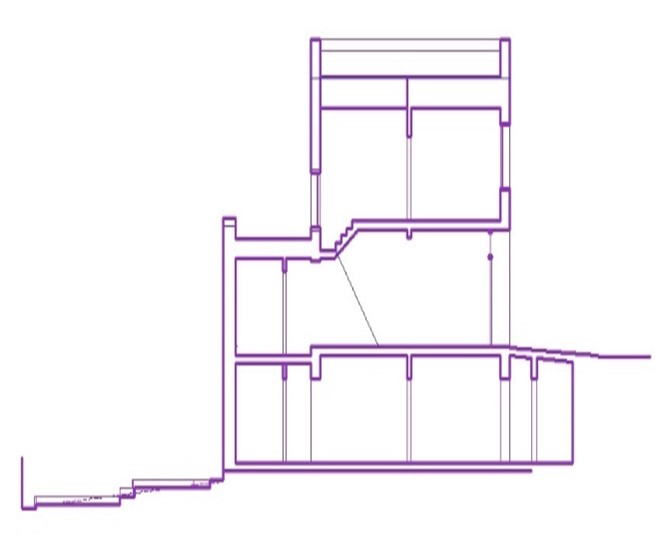 |
 |
| Floor plan | Elevation drawing |
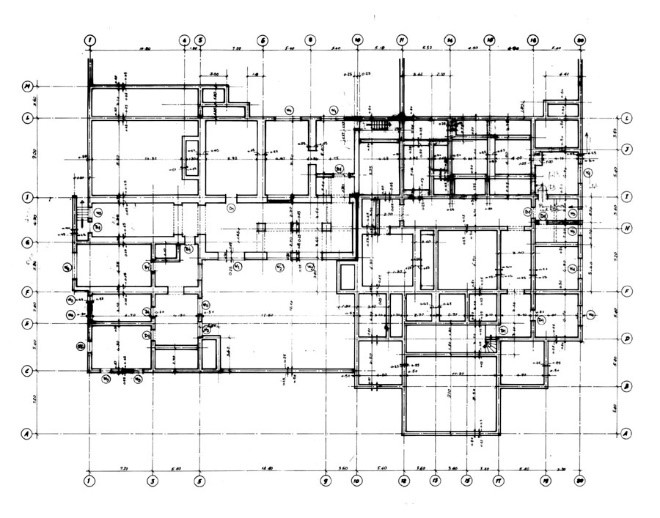 |
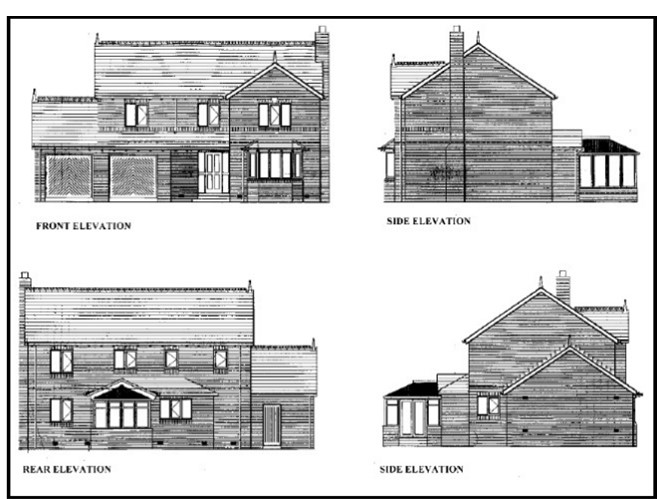 |
Variations to Construction Contract
Some variations to the contract may occur throughout the construction process. Variations may even occur as early as the approval process for the project to commence. As a person in charge of project scheduling, you must identify these variations as required by the project before or during project commencement.
Construction contracts almost always include clauses allowing the principal to vary the contract to enable the contractor to do more, less, or different work than initially negotiated. Usually, contractors have no such right to variate against the principal. However, the contractor would generally have the right to an extension of time for the project's realistic completion when the principal has requested a variation. Contractors are paid for work outside the original scope of works if the client ordered such a variation, if it is specified in the contract, or if the principal agreed to that additional work and knew or should have known that the total cost of the work would increase.
Variations may include alteration to:
| Design | Quantities | Quality | Working conditions | Sequence of work |
 |
 |
 |
 |
 |
However, these alterations must not do the following without consent from the contractor/client:
Change the fundamental nature of the works
Omit work so that another contractor may carry it out
Be instructed after practical completion
Require the contractor to carry out work that was the subject of a prime cost sum
Variations in the Scope of Works
Variations in the scope of work may come about when the contract documents do not adequately describe the works to be carried out. A difference in the building contract may be the subject of something not included in the scope of work. As such, the reach of the work must be:
 |
 |
 |
| Detailed in depth | Accurate | Complete |
If the scope of work is incomplete or includes mistakes, there may be significant time and expense impacts on the project. Before entering the contract, it is necessary to flesh out the scope of work and any requirements with the contractor. Fleshing out this information will decrease the likelihood of variations being required.
When Does a Variation Occur?
A variation occurs when:
The client changes priorities or job requirements.
The contractor acknowledges that an error or item is omitted from the scope of work or that there is extra work that was not planned at the beginning of the project. For instance, if mould remediation is found, it will need to be added to the scope of kitchen renovation or asbestos removal.
If an object or part of the job scope is removed or omitted, the client may direct a negative variation. The client determines, for example, that they no longer want the contractor to remove an existing wall.
To see how variations can be made, it is also necessary that you review the construction contract. Restrictions on the exclusion of part of the work from the scope of the work could be in place. For instance, where you find a cheaper dealer for that part of the job.
Under such cases, the contractor can have the right to refuse to agree to make a variation. The contractor can refuse any form of work considered by the contract out of the ordinary and unpredictable.
Method for Varying the Scope of Works
In general, the method of varying the scope of work is set out in detail in the building contract. If changes to the range of work are required, you must refer to the variations clause on the contract to see if the variation can be done. Generally, there must be an agreement between the client and the contractor where variations are to be done. This will usually require finding agreement on the:
- Modifications to the field of work
- Price or contract sum modifications
- To allow for the variety, any adjustment to the contractor's time to complete the works.
In general, the client is entitled to direct variations. However, these variations will typically affect the contract amount payable to the contractor and the period for the job to be completed. If the contractor feels that there is a need for a change in the nature of the work, they must contact the client and request approval before performing the necessary work. There could be a clause in the building contract that specifies whether the client may request the estimated time and cost to execute variations.

Below are the contents of a generic project start preparation template.
|
Variations to the project Variations must be determined based on a comparison against original/initial versions of documents. |
|
|
Variations to the scope of works |
|
|
Variations to the contractual terms agreed upon with client |
|
|
Variations to the arrangements agreed upon with client |
|
|
Changes to construction drawings |
|
|
Changes to construction specifications |
|
After completing this section, you should now have the information you need to fill out this section of the project start preparation template.
In a construction project, a selection of suppliers or subcontractors must be assigned to certain aspects of a construction project. Once the client or owner has selected the main contractor, suppliers and sub-contractors must be selected next. Additionally, as the person in charge of project scheduling and of the process of assessing the physical and human resource requirements of a construction project, you must be able to communicate with these suppliers and contractors effectively.
Suppliers and Contractors in Building and Construction
After the client selects a contractor, they hand the responsibility of completing the project to them. This apparent single directional agreement then divides as the construction process requires an extensive amount and variation of goods and services to be accomplished. At this stage, subcontractors are appointed to assist the main contractor in aspects of the construction assigned to them. A simple distinction between contractors and sub-contractors is that contractors are contracted to complete construction works while a subcontractor is tasked to a specific role or function.
On the other hand, suppliers provide services or goods for the completion of a construction project. Suppliers are often contracted by either the client or the contractor for their services. Contractors are typically given the freedom to purchase supplies from their own choice of suppliers as long as they comply with the requirements in the project's specifications. However, the client may nominate or impose a particular supplier to a contractor after being appointed to the construction project.
Nomination is a complicated process as it narrows towards all possible outcomes involving the client, main contractor, and the nominated party. These separate negotiations with suppliers and subcontractors allow the further development and improvement of the project design as soon as the main contractor begins working.
The process of approving contractors and selecting suppliers will vary between organisations. Organisation policies and procedures for approving contractors and selecting suppliers are established by your organisation to guarantee the transparency and reliability of the nomination process. Make sure to access and review your organisation’s policies and procedures for approving contractors and selecting suppliers.
Determining the Project Contractor
An entire project is at stake when deciding on a contractor to carry out the construction work. The process, generally known as 'tendering', should be done as carefully as possible, considering how the contract directly impacts a project's success. The tender process discussed in this section may differ from the procedure followed in your organisation. Your organisation may seek advice from consultants to assist them in the process of choosing a contractor. Be sure to access your organisation's policies and procedure for approving contractors for a construction project.
The tender process for contractors usually starts with an invitation from the client for prospective contractors to submit tender documentation to them. A tender is an offer of goods and services. Tender documents may contain the following information:
- A letter of invitation to tender
- The form of tender as prepared by the client or their consultants
- Preliminary information such as:
- Pre-construction information
- Site Management Plan
- Preferred form of contract, contract conditions, and amendments
- Pricing document or contract sum analysis
- Design drawings
- Specifications
- Tender return slip
Selecting a contractor is based on the tender submitted. A contract publicly advertised may result in a long list of interested contractors. A pre-qualification process should be done to evaluate the contractors efficiently. The procedure involves examining each contractor's experience, capacity, and financial standing to determine a short-list.
The client may also invite interested contractors to a pre-tender interview to further assess their qualifications. The following are the objectives of the interview:
| Confirm the contractors understanding of the commission | Find out the strategies and approach of the contractor to the project | Assess whether the contractor is capable of completing the project against its current workload |
 |
 |
 |
| Verify how interested the contractor is on the project | Ensure that the contractor can achieve the proposed timescale for the tender process | Ensure that the contractor can obtain the best results as indicated in the tender process |
 |
 |
 |
The Tender Process
Accommodating queries and clarifications from interested contractors, pre-tender interviews, and site visits are considered part of the tender process. This process leads to the selection of the project contractor. Overall, this benefits both the client and the tenderer in producing and submitting an accurate tender. The tender process also opens possible opportunities and insights for the client and even identify potential problems along the way.
The selection of a contractor is a balance between price and value. Evaluating the performance of the contractor is based on the predefined selection criteria, which may include the following:
- Previous performance
- Experience relevant to the project
- Technical ability
- The ability of the tenderer to sustain the project
- Health and safety record
- Innovation
- Resource Availability
- Management skills
- Systems and proposed methodology
Approved Contractor
The contractor who has demonstrated having the expertise, resources, ability, and desire to tender for a proposed project is subject to approval. The client can then proceed with tender negotiation with the preferred contractor.
The areas of a contract that may need further negotiation may include the following:
| Price agreed upon | The project start date and target completion date | Ability to modify the building programme |
 |
 |
 |
| Ability to claim extensions of time or damages | The time frame for payments | Insurance requirements, warranties and bonds |
 |
 |
 |
| The scope of work and duties | Valuation of payments and variations | Testing and inspections |
 |
 |
 |
| The use of subcontractors or sub-consultants | Novation of consultants or consultant switch |
 |
 |
Nominated and Approved Supplier
The selection of the supplier usually depends on the choice of the contractor. The contractor may purchase goods or services from their chosen supplier as long as they comply with the specifications' requirements. However, the client may insist on or nominate another supplier of the main contractor appointed. The process for selecting suppliers for a construction project will depend on your organisation's policy and procedures. Be sure to access and review your organisation's policy and procedure for selecting suppliers for a construction project.
The client may prefer a particular supplier for the following reasons:
- Previous work history or relationship with the supplier.
- The prefered supplier can provide widely limited goods.
- The supplier has a specific product brand required.
- Transactions have been made with the supplier prior to appointing the main contractor because of expected long delivery.
- During the early stages of development, specialist design inputs were necessary.
- The supplier can provide complex or specialist industrial plant or equipment needed based on the design.

Apart from the client's preference, it is important to consider that the suppliers nominated have the best interest of the project and the capacity to satisfy project specifications, programme, and budget. The client is then responsible for the performance of the supplier. If the contractor fails, the client must ensure that they have a direct warranty with the nominated supplier. This warranty means that the supplier must guarantee satisfactory performance.
The organisation or the project contractor can produce a list of nominated suppliers preferred by a client to undertake specific works, supplies, or services. This process also includes tendering to determine the selection and approval of suppliers. An approved list, or approved supplier list, is a document of potential contractors, suppliers or service providers approved by the client who have met pre-set criteria. Approved suppliers may be asked to sign a supplier contract to put into legal writing the responsibility of the supplier to provide service throughout the construction process.
As the person in charge of labour and material scheduling, you must keep a list of the approved contractors and suppliers of the construction project and their contact information. With a contractors and suppliers list, you have a handy reference for whom to contact for various reasons such as issues during the construction process. Below are examples of generic contractors and suppliers list templates.
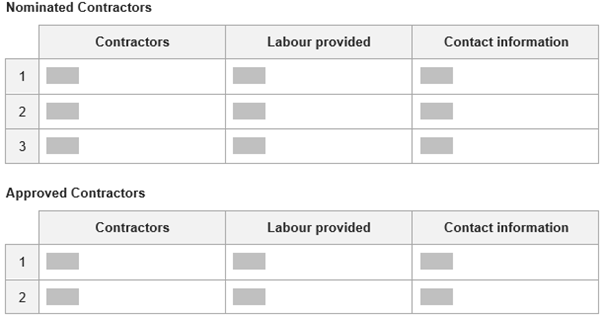
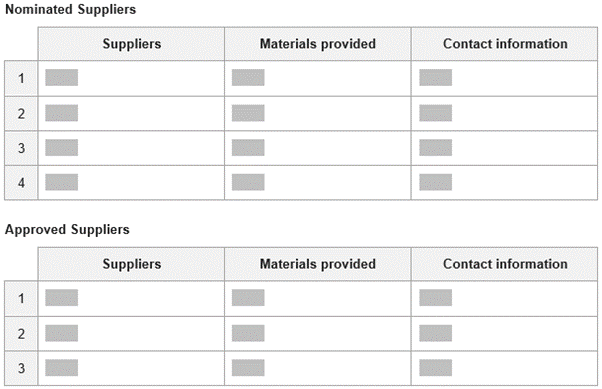
Develop and Manage Efficient Communications Between Contractors and Suppliers

Communication plays an integral role not only in the construction workplace but in any setting. Developing communication methods takes experience and evaluation, continuous improvement, and finding ways to manage a team. The construction work set up requires the establishment of reliable communication where crucial information is safeguarded to be accurate.
Effective Communication Channels
Your workplace must have effective communication channels in place to execute project tasks efficiently. Although these communication approaches and methods may vary from one workplace to another, it is widely regarded that effective communication directly influences the project's overall success.
Communication channels have been evolving ever since, and their capabilities outweigh any of their limitations. Choosing the best medium of communication in the organisation is considered an essential factor in keeping everyone productive, engaged, included, and well-directed with your goals. In the building and construction industry, communicating with your contractors and suppliers prove even more critical. Managing the construction project involves aiming to reach target deadlines and milestones according to schedule. The clear and concise communication with stakeholders and everyone involved in the project impacts these goals.
The following are some points to consider when choosing your communication channels:

The communication methods used in the building and construction industry are flexible and adapts well to the varying workplace situations and stages throughout the project. Communication with relevant contractors, suppliers, and stakeholders can be through any of the following channels:
- Emails
- Face-to-face verbal communication
- Mobile telephones
- Fixed telephones
- Site diaries
- Written reports
- Memoranda

Your organisation’s policy and procedure for contacting contractors and engaging with suppliers will dictate the exact method of communication you will use. Organisational policies and procedures for contacting contractors and suppliers are established by your organisation to ensure the transparency, reliability, and uniformity of communications between other parties. Make sure to access and review your organisation’s policies and procedures when interacting with contractors and suppliers.
The information on materials and labour requirements in a project is found in the building contract. The contract explicitly outlines all the materials needed for each stage of the construction and the equivalent labour. With this information, the accurate and timely follow-up and confirmation of materials with suppliers and labour with contractors can be ensured. Following-up with suppliers and contractors prevent any significant delays or misunderstanding and proves to be a useful approach to reverse or lessen any potential problem. Frequently updated information on material and labour needs is substantial for the completion of the project.
Material Procurement in Building and Construction
Construction materials are ordered from the approved suppliers through material procurement. The process involves selecting materials, ordering, invoicing, payment, and delivery to the site. The specifications of materials are based on the client's and contractor's objectives as construction activities progress. The material procurement process, which includes the costing and ordering of materials, may vary between organisations. Organisational policies and procedure for costing and ordering materials refer to the established process of material procurement by your organisation to ensure reliability and uniformity. Your organisation may have a procurement team, or a construction buyer may be assigned by the organisation for the procurement activities for the materials. Be sure to access your organisation's policy and procedure for material procurement.
Factors such as the speed of delivery must be considered in the purchasing of materials. The orders must be transacted with the supplier and brought on-site as soon as it is needed. Timing of delivery must be carefully planned to prevent filling the worksite and ensure materials' availability during construction works.
In confirming the availability of materials from the supplier, the following information should be discussed and verified:
What materials need confirmation from the supplier
What means and method of transportation will be used to deliver materials
Schedule of material delivery in bulk
Schedule of delivery of materials
All information necessary should be given to the supplier to make sure that orders are correct and according to the specifications. The relevant personal assigned to confirming availability if materials should be responsive in any clarifications, and the supplier should be given a contact person if a concern should arise. Confirmation of materials must correspond to the project schedule to prevent a sequence of delays. However, if confirmation was not made in time, the management must set new deadlines immediately, evaluate the impact of the situation, and make necessary adjustments.
Labour Management in Construction
The accurate identification and procurement of construction materials are only some of the essential requirements for a project. Labour activities put the construction activities into action towards the completion of a project. These may refer to unskilled, manual workers on site. These workers are usually employees of a contractor, or subcontractor, or temporary workers hired for a project.
Determining Labour Requirements
The amount of personnel needed for a construction project relatively depends on the size of the project. Checking the size of the project should be the first approach to quantifying labour requirements. Analyse the project's size compared to the expected timeline and calculate the number of workers needed for its completion. This comparison should resonate with the personnel provided by the contractor or subcontractors.
In confirming labour services with a contractor, the following are some of the information that should be discussed and verified:
- The labour requirements of the project and the ability of a contractor to provide them with
- The availability of labour services of a contractor
- The number of personnel available from the contractor
Provide as much information as needed by the contractor for them to comply with labour services requested. Clarify any if there queries and be responsive. Like suppliers, in cases where the contractor cannot meet deadlines, the management may proceed with their protocol. Again, the project schedule must take necessary adjustments and mediating action to lessen the delay's impact. Communicate with the contractor and initiate solving the problem together.
As leverage to potential problems in labour availability, the main contractor or the project manager should designate personnel with the task of confirmation. The person should be given a clear timeline of labour confirmation, and deadlines must be set. Labour needs must be provided aligned with the project schedule and based on its progress.
Communicating with Suppliers and Contractors
As discussed in the previous section, clear and constant communication with the suppliers and contractors are essential in a construction project. Confirming the availability of materials with suppliers and labour with contractors requires effective and dependable communication. The communication needs to be systematic and works in tandem with project needs from one task to another.
Devices used for information dissemination are essential in dealing with suppliers and contractors for project needs. These devices make communication instantaneous and are easily accessible. It is important to take advantage of readily available communication tools in working with suppliers and contractors.
The following are examples of digital devices used in communicating with suppliers and contractors:
- Phone calls
- Text messaging
- Instant messaging
- Radio communication
- Intercom
As mentioned in previous section, how you contact contractors and suppliers will depend on your organisation’s policies and procedure for contacting them. Make sure to access and review your organisation’s policies and procedures for interacting with other parties.
The project schedule serves as the framework of the entire project. It is composed of relevant information, including the sequence of tasks and the expected duration of each. This outline specifies the milestones needed to be completed, which gives a general understanding of the project progress. The plan also indicates the necessary dependencies and resources required to ascertain that these tasks and milestones are achieved.
Critical project information refers to aspects of a construction project that is vital for its completion. These can be conditions of approval that the project must meet before it can begin or unavailable materials specified in the construction drawings and specifications. These are information that you must account for when preparing to produce project schedules. At this point of the unit, critical project information will comprise the conditions of approval of the project, availability of materials and labour, and variations to the scope of works and contractual terms and agreements due to conditions of approval and materials and labour availability. For now, this information should be placed in a project start preparation document which you have been filling out through this chapter.
Project schedules essentially function as the timeframe that details all the activities required to complete a project. The following are some formats the project schedule may follow:
| Gannt chart | Network diagram | Critical path method | Program Evaluation Review Technique (PERT) Chart |
 |
 |
 |
 |
The schedule may then include the following information:
- Sequence of tasks or activities
- Milestones
- Start date
- End date
- Duration of task or activity in days
- Material Procurement date
- Expected delivery date
- Labour confirmation
- Labour schedule


